Mycoplasma in poultry is a highly contagious respiratory disease affecting chickens, turkeys, pheasants, and waterfowl, especially in backyard flocks. Often mistaken for a common cold or roup in older literature, this condition has gained attention due to its spread through mixed stock, travel, and stressors. With clinical signs appearing in just a few days, understanding mycoplasma in poultry is crucial for flock owners to maintain bird health, egg production, and growth. This guide covers everything from causes and symptoms to effective prevention strategies, drawing on veterinary insights for backyard poultry keepers.
Disease Background
Mycoplasma infections in poultry have historical roots, with symptoms described over a century ago in veterinary texts. Traditionally managed by culling affected birds, the disease was renamed once the causative organism—Mycoplasma species—was identified. It primarily targets the respiratory system and thrives in environments with secondary pathogens like E. coli or infectious bronchitis virus (IBV), which is increasingly common in free-range setups.
Stressors exacerbate the issue, including nutritional shortfalls, high ammonia or dust levels, flock hierarchy changes, or exhibition travel. In modern backyard settings, where birds from various sources mix, mycoplasma spreads rapidly, impacting welfare and productivity.
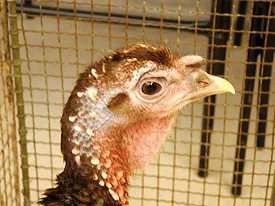 Normal turkey head (note quite sunken appearance): Bourbon Red female
Normal turkey head (note quite sunken appearance): Bourbon Red female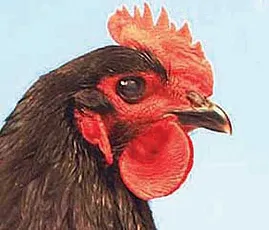 Normal chicken head: Australorp female
Normal chicken head: Australorp female
Causes and Clinical Signs
Mycoplasma organisms are unique, smaller than bacteria but larger than viruses, lacking a cell wall and protected by a plasma membrane. Of the 17 known species, four are pathogenic to poultry:
- Mycoplasma gallisepticum: The primary concern in backyard flocks, causing foamy eyes, sneezing, nasal discharge, swollen sinuses and eyelids, reduced egg production, and gasping in chickens, turkeys, pheasants, and waterfowl.
- Mycoplasma synoviae: Leads to swollen, hot joints in chickens and turkeys, respiratory issues, or thin, deformed eggshells at the broad end.
- Mycoplasma meleagridis: Results in poor growth in turkey poults and lower hatchability in breeders.
- Mycoplasma iowae: Reduces hatchability and causes twisted legs in turkey poults.
Nasal discharge often stains feathers as birds attempt to clean their faces, accompanied by a distinctive sweet odor noticeable upon entering the coop. These signs worsen with concurrent infections or poor conditions, underscoring the need for vigilant monitoring in home flocks.
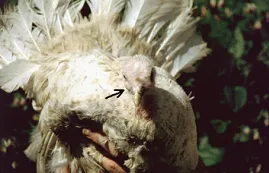 Nebraskan Spotted Turkey with Mycoplasma. Note swollen sinus (arrowed)
Nebraskan Spotted Turkey with Mycoplasma. Note swollen sinus (arrowed)
Transmission
The pathogen survives well in nasal discharge, especially in cool temperatures, with sneezes dispersing infective droplets that remain viable for days. Vertical transmission occurs through eggs, while horizontal spread happens via contaminated clothes, hands, equipment, or direct contact. Backyard poultry enthusiasts must prioritize biosecurity to curb this rapid contagion.
Economic Impact and Diagnosis
Mycoplasma in poultry leads to tangible losses: decreased egg output, slower weight gain, and poorer hatch rates across chickens, turkeys, waterfowl, and game birds. Diagnosis relies on characteristic clinical signs—swollen sinuses, nasal discharge, joint issues, or shell deformities—often confirmed by veterinary lab tests for definitive species identification.
 Swollen hock due to Mycoplasma synoviae
Swollen hock due to Mycoplasma synoviae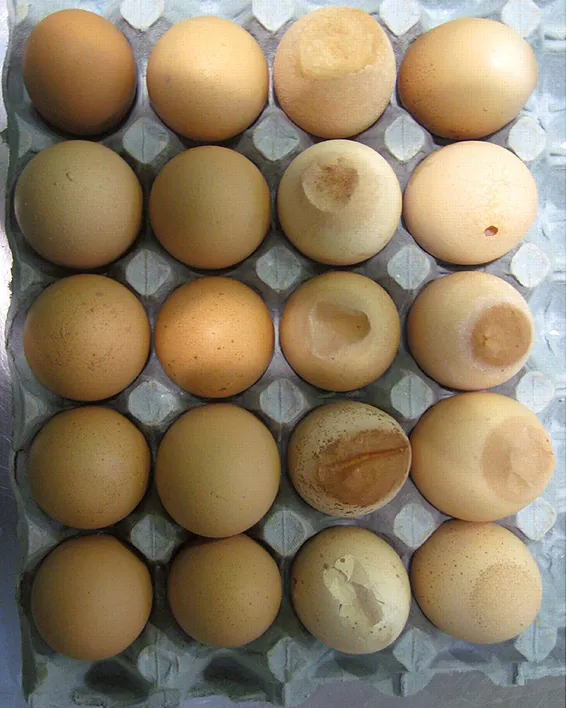 Apical shell deformities due to Mycoplasma synoviae
Apical shell deformities due to Mycoplasma synoviae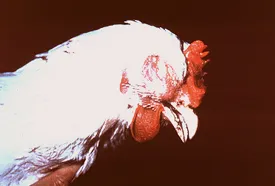 White Orpington with severely swollen sinuses and nasal discharge
White Orpington with severely swollen sinuses and nasal discharge
Treatment Options
While antibiotics don’t eradicate mycoplasma entirely, they suppress it to manageable levels. Tylan Soluble (tylosin) is licensed and highly effective, particularly in young birds or early outbreaks. Administer promptly in drinking water; older birds may require higher doses at acute stages. Avoid Baytril Oral in laying hens due to egg withdrawal periods. If symptoms persist post-treatment, cull the bird to prevent carrier status and ongoing spread. Note: Denagard (lincomycin) can be used in layers but avoid combining with certain coccidiostats in grower feeds, as it may prove fatal.
Veterinary guidance is essential, as per recommendations from organizations like the National Animal Disease Information Service (NADIS), to ensure safe, species-appropriate dosing.
Prevention Strategies
Proactive measures are key to controlling mycoplasma in backyard poultry:
- Minimize stressors with vitamin/probiotic supplements (e.g., water additives) before events like shows.
- Disinfect huts and gear using Virkon or F10.
- Maintain ventilation to reduce dust and ammonia, which impair tracheal cilia function.
- Provide age- and species-specific commercial feeds for optimal nutrition.
- Monitor weather and start daily checks with clean clothes on youngest birds.
- Quarantine new stock 2-3 weeks or treat immediately with Tylan if flock history includes mycoplasma.
- Avoid auctions; source from reputable, tested breeders.
- Keeping adults symptom-free lowers egg transmission risk.
- Mild early exposures can build immunity sans secondary pathogens.
- Add cider vinegar (10ml per 500ml water, plastic drinkers only) weekly or more during outbreaks to boost immunity and clean waterers.
- Implement full biosecurity protocols.
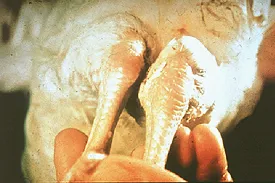 Swollen hock (Fig 4) and Apical eggshell deformities (Fig 5) both due to Mycoplasma synoviae
Swollen hock (Fig 4) and Apical eggshell deformities (Fig 5) both due to Mycoplasma synoviae
Vaccination Considerations
MSD offers a mycoplasma vaccine, but it’s not advised for breeding chickens due to uncertain duration of immunity. Consult vets for flock-specific advice, prioritizing prevention over vaccination in backyard settings.
Conclusion
Managing mycoplasma in poultry demands vigilance, biosecurity, and swift action to safeguard flock health and productivity. By recognizing early symptoms like swollen sinuses and nasal discharge, applying targeted treatments like Tylan Soluble, and adopting preventive habits such as proper ventilation and quarantine, backyard keepers can keep incidence low. Always seek professional veterinary input for tailored plans, enhancing bird welfare. For more poultry health tips, explore resources from trusted vets and share your experiences in the comments below!
References
- National Animal Disease Information Service (NADIS): nadis.org.uk
- Poultry veterinary guidelines from MSD Animal Health.
